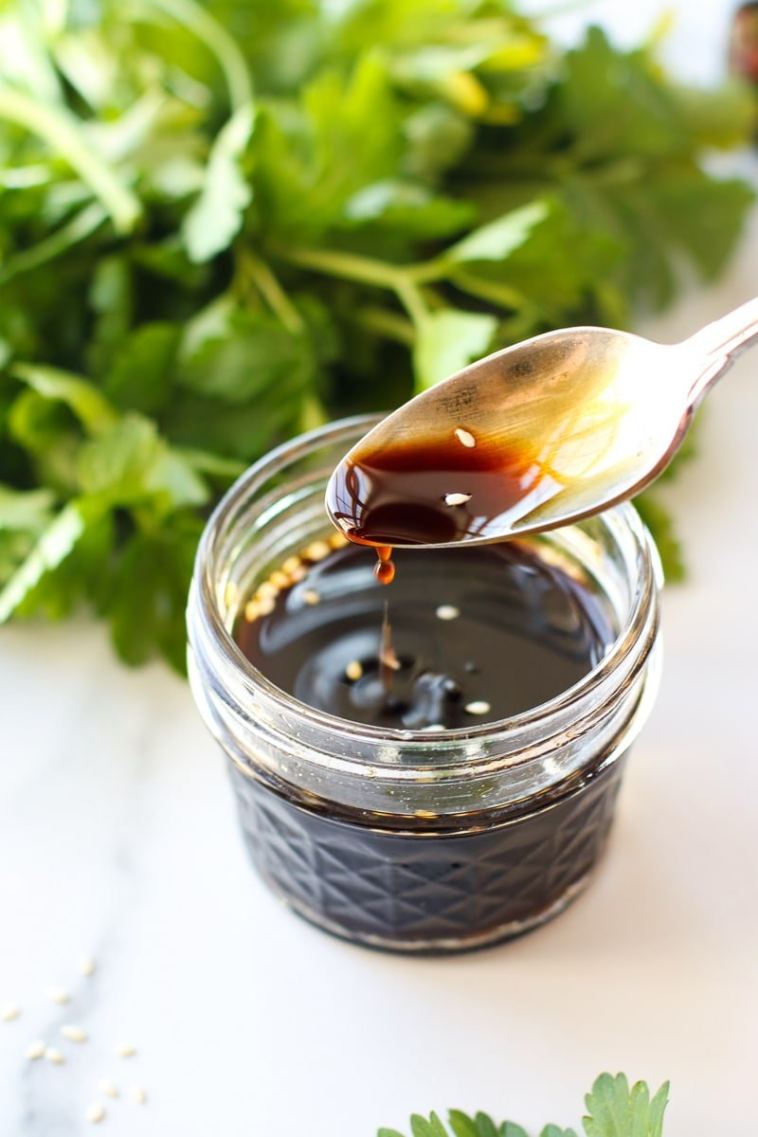- Like
- SHARE
- Digg
- Del
- Tumblr
- VKontakte
- Flattr
- Buffer
- Love This
- Save
- Odnoklassniki
- Meneame
- Blogger
- Amazon
- Yahoo Mail
- Gmail
- AOL
- Newsvine
- HackerNews
- Evernote
- MySpace
- Mail.ru
- Viadeo
- Line
- Comments
- Yummly
- SMS
- Viber
- Telegram
- JOIN
- Skype
- Facebook Messenger
- Kakao
- LiveJournal
- Yammer
- Edgar
- Fintel
- Mix
- Instapaper
- Copy Link
Coconut aminos (also called coconut liquid aminos or coco aminos) are a healthful flavoring ingredient that we like to keep in our pantries and use in a variety of recipes. Read this post to learn more about what coconut aminos are, how to use them, coconut aminos substitutes, and our favorite brands. You’ll soon be using coco aminos like a pro and you’ll reach for this ingredient whenever you want a punch of savory flavor, similar to that of soy sauce, shoyu, or tamari, but with a lot less sodium.
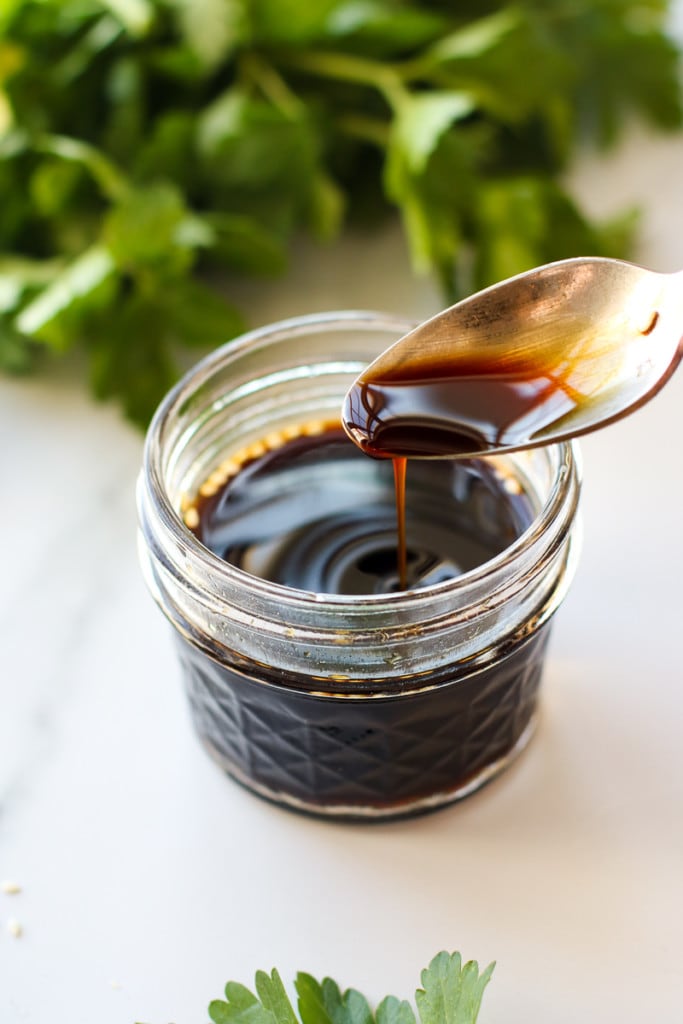
what are coconut aminos made from?
If you’re here because you’ve seen this ingredient in recipes and you’re wondering, “OK, what is coconut aminos?” then you’ll learn it all now. Coco aminos are a dark, thin sauce (similar to soy sauce or a thin teriyaki sauce) made from the sap or nectar of a coconut palm tree. Whereas coconut oil is made from mature coconuts, coco aminos is made from the sap of young flowers of a coconut tree. The unopened coconut blossoms are tapped and the nectar is collected. The nectar is then fermented with salt to create a savory, umami-providing flavoring sauce. Coco aminos are made simply by fermenting coconut sap and salt, that’s it.
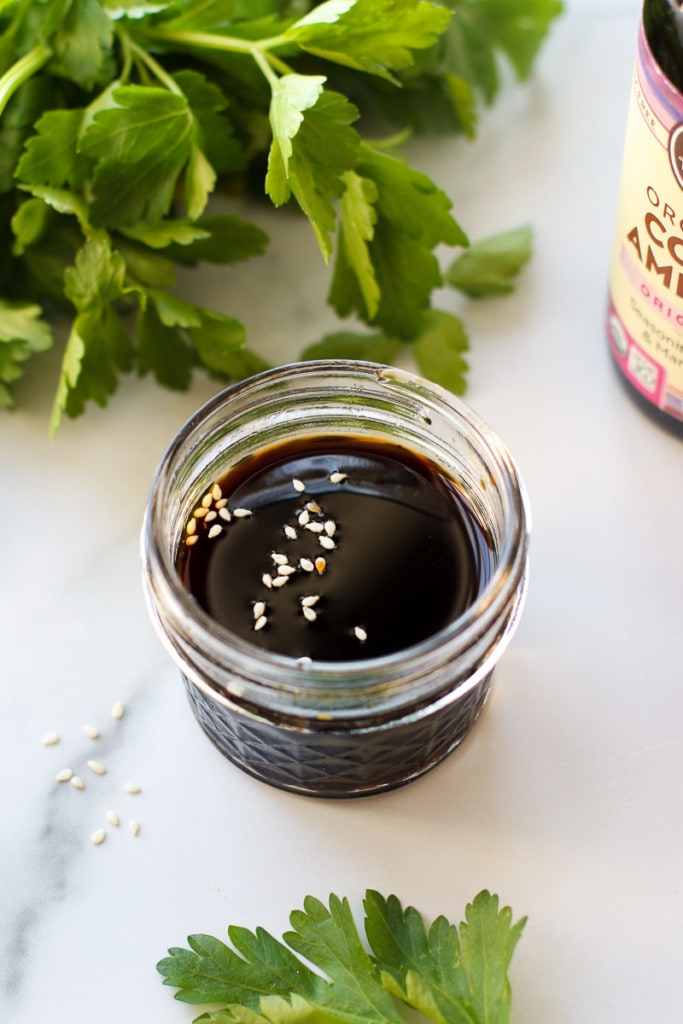
what are the benefits of coconut Aminos?
We like to call for coconut aminos for a few specific reasons, including these health benefits:
- A simple real-food condiment: this condiment is made from just two ingredients: coconut sap and sea salt. Other similar-type flavoring sauces often contain undesirable additives, such as thickening agents or chemical preservatives, MSG, added sugar, “natural” flavorings, or added colors. But coconut aminos are a simple, clean condiment made from a whole-food ingredient
- Low-sodium alternative: coconut aminos don’t just contain a little less sodium than soy sauce. Rather, coco aminos contain A LOT less sodium than soy sauce and other similar products. That’s right, coconut aminos have a whopping 70 to 75% less sodium than regular soy sauce while still providing a savory, salty flavor to recipes
- Soy-free, grain-free, gluten-free, dairy-free: we also like to use coco aminos because it is an allergen-friendly alternative to similar products. Coconut aminos don’t contain any soy, gluten, grains, dairy, nuts or other common allergens. For this reason, it is are a good choice for someone who is avoiding soy, gluten, grains, or other common allergens
- Great flavor: because of the name, many people think that coconut aminos will taste like coconut, but that’s not true. Coconut aminos is a dark brown, salty, thin and liquid sauce. It has very, very mild sweetness, and tastes similar to low-sodium or mild soy sauce as a flavoring agent
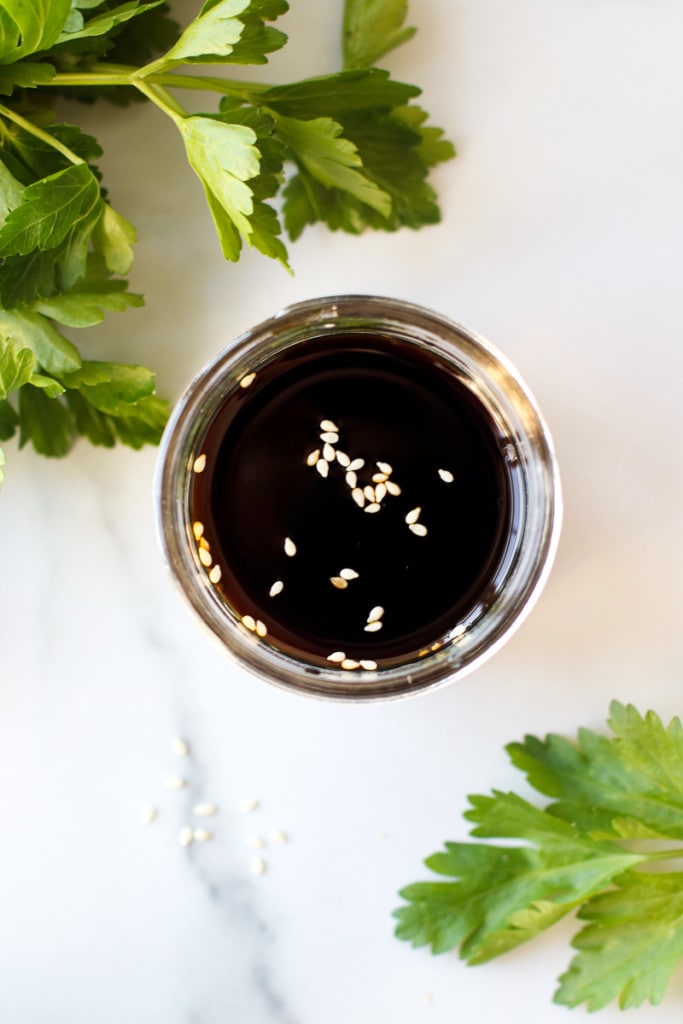
Is coco aminos Vegan? is coconut aminos Whole30?
One of the reasons we like to use coco aminos is because it meets the requirements of many special diets. Since this condiment is made simply from the nectar of coconut blossoms plus salt, coconut aminos is gluten free, grain free, soy free, vegan, nut free, plant-based, Paleo, keto (ketogenic), Whole30 friendly, low glycemic, and contains no refined sugars.
do coconut Aminos taste like coconuts?
It is natural to think that coco aminos may taste like coconuts, since the sauce is derived from the sap of coconut palm trees. However, coconut aminos do not taste at all like coconut, in any way. Instead, when you taste coconut aminos, what you’ll experience is a mild savory sauce. It has very slight sweetness and a mild buttery aftertaste. Coco aminos are pleasant to use as a dipping sauce and also in a variety of recipes.
Coconut Aminos Substitute: What to use instead
What if you don’t have coconut aminos on hand? You may be wondering: What can I use instead of coconut aminos in a recipe? Well, we have a very simple formula that you can follow to replace coco aminos with soy sauce, tamari, or shoyu, if that’s what you have in your pantry instead.
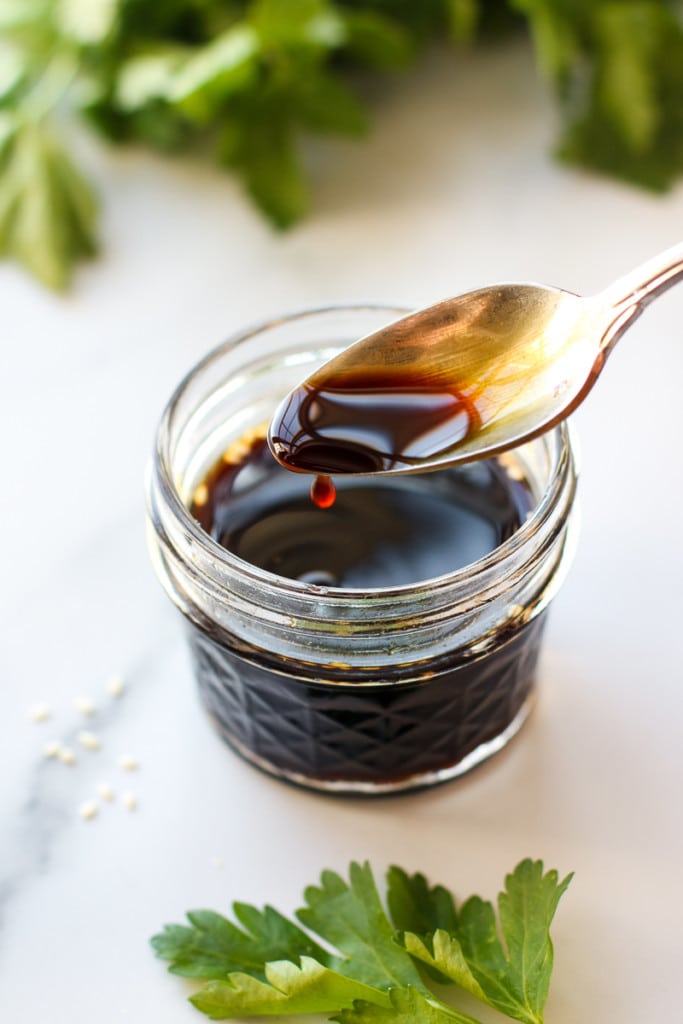
compare: Coconut aminos vs Soy Sauce
Coco liquid aminos are often compared to soy sauce. And though coco aminos is not exactly like soy sauce (it has a much milder, less salty flavor), it is close. Coco aminos can be used interchangeably in recipes where soy sauce, shoyu, and tamari are called for. See below for the formula to sub in coco aminos in place of one of these common sauces.
Soy sauce – When you see soy sauce, it almost always refers to Chinese-style soy sauce, which is typically made from 100% fermented soybeans. Some, but not all, soy sauces contain wheat, added sugar and/or salt. And all soy sauce contains soy since they are derived from soy beans
Shoyu – While also called soy sauce, shoyu is a special Japanese-style soy sauce that is made from a mix of soy and wheat. It is slightly thicker and less transparent than soy sauce. Shoyu is mostly not gluten-free or wheat-free and it is a soy-based sauce that contains soy
Tamari – This ingredient is often called for as a gluten-free alternative to soy sauce or shoyu. It is a soy-based byproduct of making miso, and classically it’s made with soy. It is most often gluten-free and wheat-free but does contain soy

Sodium in soy sauce vs coconut aminos
One of the benefits of using coco liquid aminos is that it contains quite a bit less (as in 70 to 75% less) sodium than comparable products, even low-sodium versions. Using coco aminos is a great way to reduce sodium while still getting terrific salty flavor. Many people find it desirable to use a lower-sodium product to help reign in too much salt. A high-sodium diet can contribute to poor cardiovascular health and increased blood pressure in some people.
- 1 tablespoon tamari = 1,000 milligrams sodium
- a tbsp soy sauce = 920 milligrams sodium
- 1 tablespoon shoyu = 880 milligrams sodium
- a tbsp low-sodium soy sauce = 533 milligrams sodium
- 1 tablespoon coco aminos = 250 milligrams sodium
how to replace coconut aminos in a recipe
Wondering what you can use as a coconut aminos substitute? Use this formula to replace coco liquid aminos with soy sauce, tamari, or shoyu:
When a recipe calls for coconut aminos, use half the amount of soy sauce mixed with half the amount of water.
If a recipe calls for 1/2 cup coconut aminos, use 1/4 cup soy sauce mixed with 1/4 cup water
If a recipe calls for 1/4 cup coconut aminos, use 2 tablespoons soy sauce mixed with 2 tablespoons water
~ The Real Food Dietitians
Tip!
how to replace coconut aminos in a recipe
When a recipe calls for coconut aminos, use half the amount of soy sauce, tamari, or shoyu mixed with half the amount of water. For example, if a recipe calls for 2 tablespoons of coconut aminos, you can use 1 tablespoon of soy sauce mixed with 1 tablespoon of water instead.
how to replace soy sauce with coconut aminos
Likewise, you may be wondering what are some soy-sauce substitutes, especially if you’re looking for ways to cut down on sodium. Or maybe you just want a gluten-free, cleaner alternative to soy sauce. Use this formula to replace soy sauce with a coconut aminos substitute:When a recipe calls for soy sauce, use twice the amount of coconut aminos.
If a recipe calls for 1/4 cup soy sauce, you can use 1/2 cup coconut aminos instead
If a recipe calls for 2 tablespoons soy sauce, you can use 1/4 cup coconut aminos instead
The Real Food Dietitians
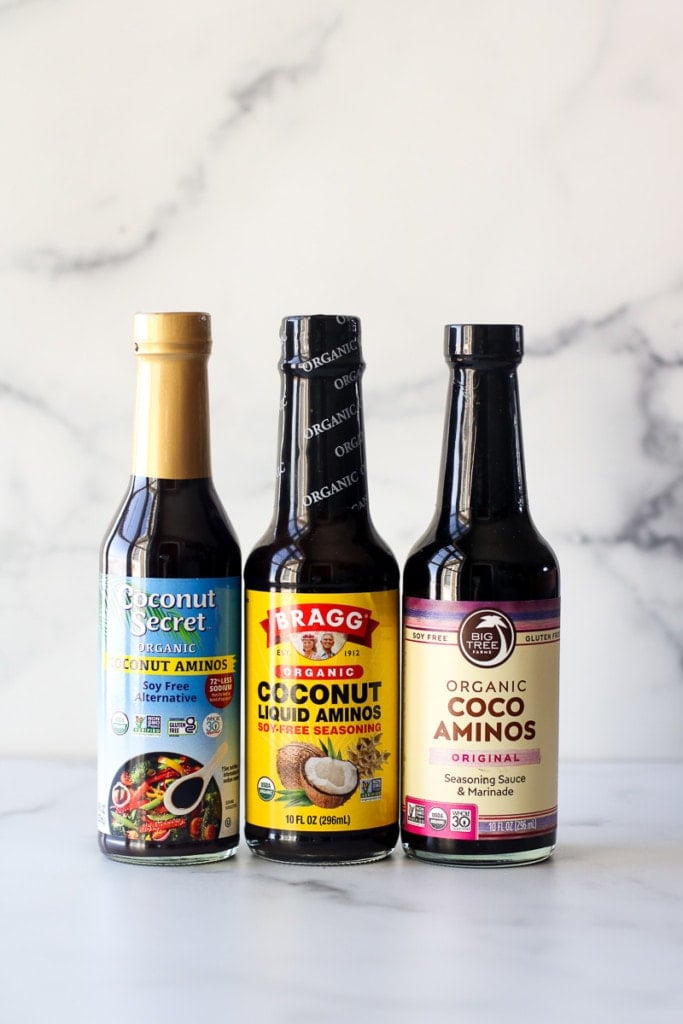
The Best brands of Coconut Aminos We Recommend
We’ve been using coconut aminos for many years and we’ve discovered our favorite brands based on taste and nutrition quality. Here are the three brands that we recommend most often. We’ve linked to each one so you can check it out yourself or order some for your own pantry (or pick up from your local grocery store or natural foods store).
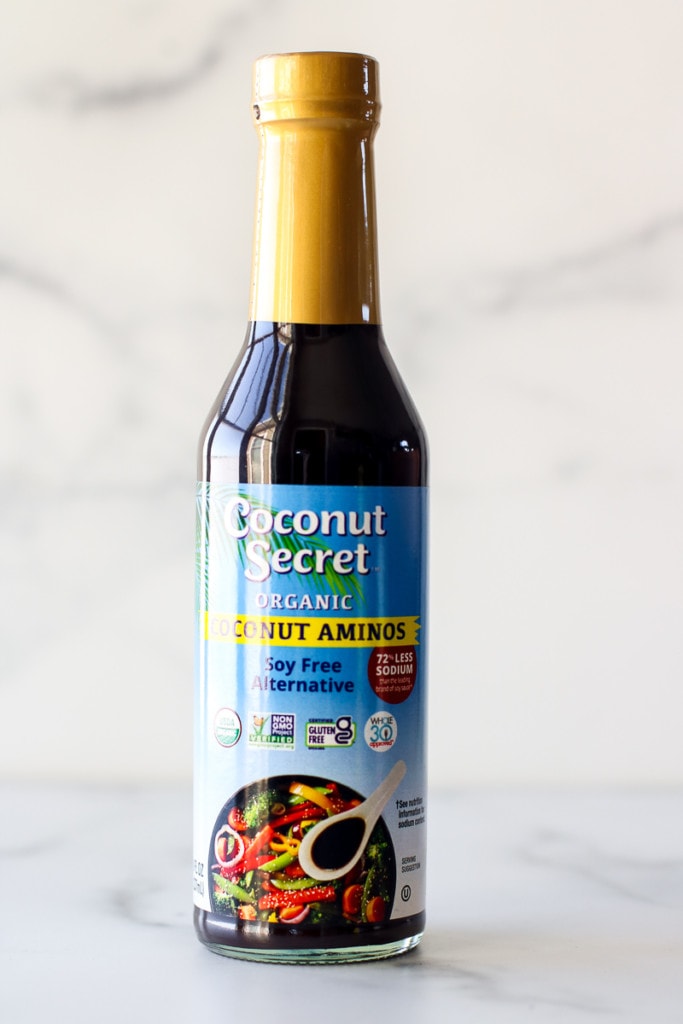
- Coconut Secret Organic Coconut Aminos – we recommend this brand most often because it is the lowest in sodium. And we also love this brand’s fair trade, sustainable sourcing of coconut-based products. Coconut Secret also makes coconut-based marinades, sauces, vinegars, and nectar. One tablespoon of Coconut Secret Organic Coco Aminos contains 15 calories and 270 milligrams of sodium. We also like that you can purchase this brand directly through Thrive Market.
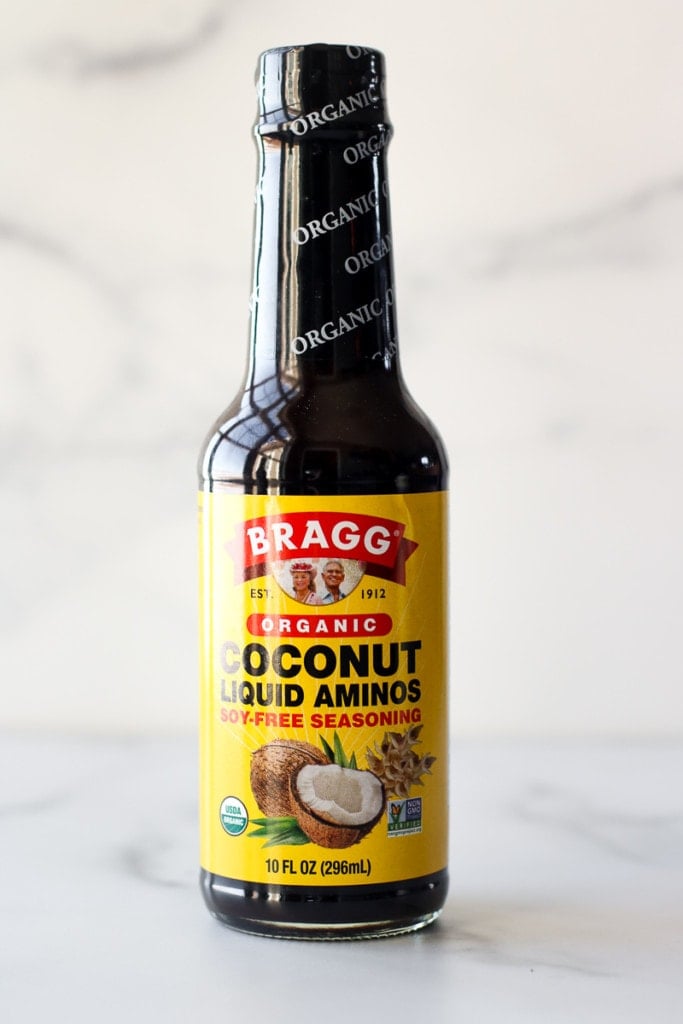
- Bragg Organic Coconut Liquid Aminos – this is our go-to brand for the best price and easy-to-find liquid organic coconut aminos. You may know Bragg for its famous apple cider vinegar. This brand also makes many different sauces, beverages, and pantry ingredients. One tablespoon of Bragg Organic Coconut Liquid Aminos contains 30 calories and 420 milligrams of sodium.
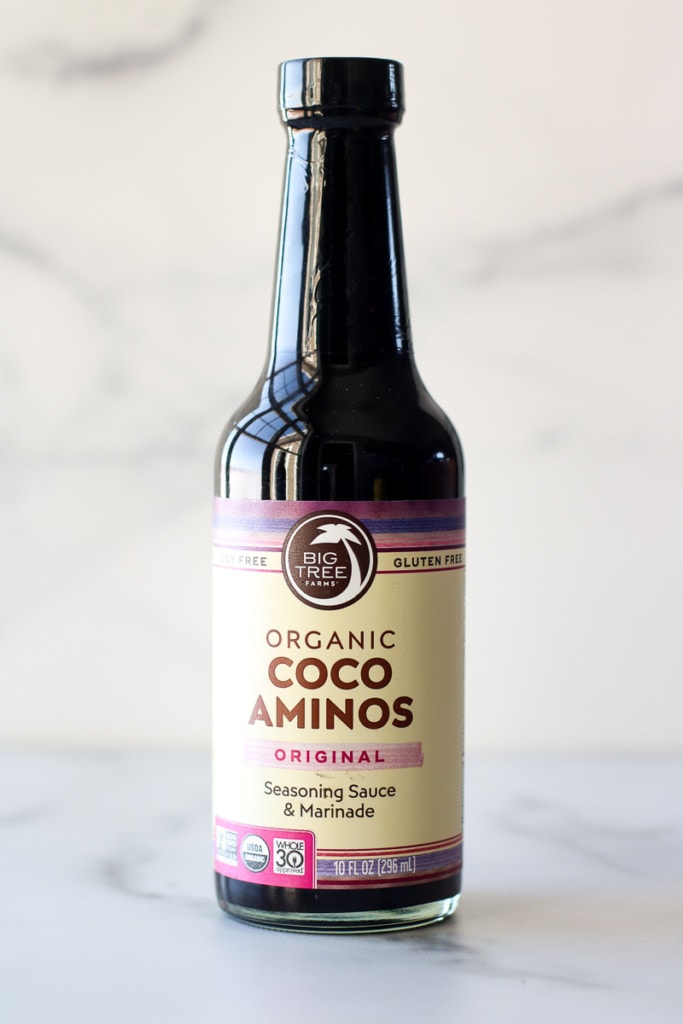
- Big Tree Farms Organic Coco Aminos – we love this brand because it is organic, tastes great, and is cleanly made. Big Tree Farms also makes a variety of coconut-based marinades, as well as coconut sugars. The coco aminos from Big Tree Farms is brewed in small batches. One tablespoon (that’s three teaspoons) of Big Tree Farms original coco aminos contains 25 calories and 490 mg of sodium.
ways to use coco Liquid Aminos
You can use this flavorful salty condiment in a variety of ways, including:
- as a dipping sauce for egg rolls, sushi, or spring rolls
- as a low-sodium alternative to soy sauce, tamari, or shoyu
- a low-sodium, plant-based, and vegan alternative to fish sauce
- a seasoning for fried rice or cauliflower fried rice
- drizzled over roasted veggies
- as a marinade for pork, chicken, shrimp, or steak
- stirred into soups, stews, stir fry, or casseroles for a dash of umami flavor
- as a component of better-for-you homemade salad dressings or condiments, such as Homemade Buffalo Sauce
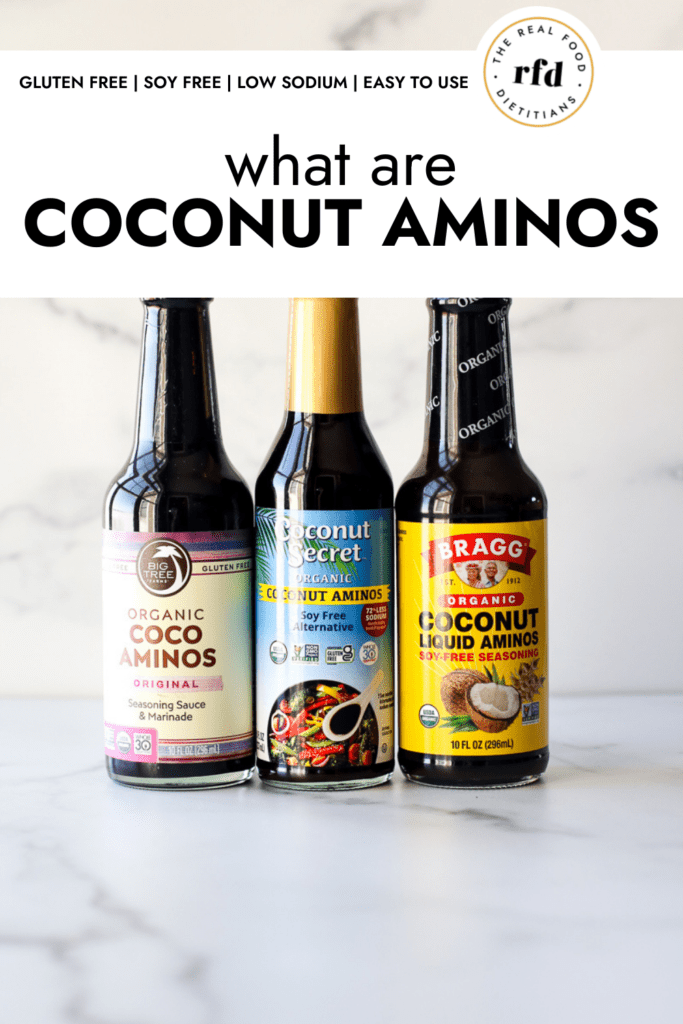
Our photos and content are copyright protected. Please do not use our photos or content without prior written permission. If you wish to reference this content, please link back to the source here on The Real Food Dietitians. Thank you!
